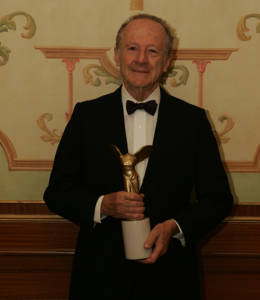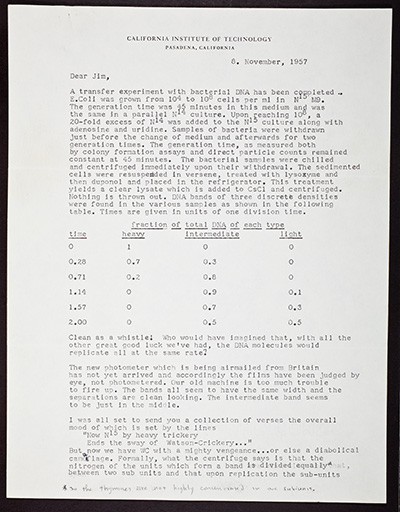When Matthew Meselson was a chemistry graduate student at the California Institute of Technology (Caltech) in the early 1950s, he and a friend tried to arrange a conference on the health effects of fallout from atmospheric nuclear weapons testing. Meselson’s adviser, Linus Pauling, intervened. Pauling combined science and activism during his career, winning Nobel prizes for chemistry and peace, but he counseled Meselson, “Get your degree, and then maybe someone will listen to you.”

Meselson with his Lasker Award (2004)
Meselson heeded Pauling’s advice and went on to make a major impact as a scientist and as an activist. In the lab, the recipient of the 2004 Albert Lasker Award for Special Achievement in Medical Science performed several landmark molecular biology studies, including what’s been dubbed “the most beautiful experiment in biology,” which answered a crucial question about how cells duplicate their DNA. Meselson’s efforts were also instrumental in the United States’ decision to stop producing biological weapons and in the adoption of an international treaty to ban these weapons.
His success in both fields has drawn praise from researchers as well as from world leaders. “I developed early on an appreciation for his open, imaginative approach to science,” says molecular biologist Philip Hanawalt of Stanford University. “I am as impressed by his work on social concerns as I am by his science,” he adds. According to former United Nations secretary-general Ban Ki-Moon, Meselson’s contribution to biological weapons control was so important that “he deserves humanity’s profound gratitude.”
Born in 1930, Meselson says he was interested in science from early in life. “When I was two or three I was fooling around with wires and batteries,” he says his mother has told him. By the time he was in high school in Los Angeles, he was using his home chemistry lab, which filled his parents’ garage, to earn money by isolating rare-earth elements for a New York chemical supply house. Meselson says he had also developed “an intense interest in how you could put together the elements of the periodic table and have something that is alive.”
His attempts to pursue that interest ran into some unexpected roadblocks, however. By taking classes during the summers, he completed enough academic credits to graduate from high school a year early. To his dismay, the school couldn’t grant his diploma because he hadn’t completed the three years of physical education that California required. Meselson rejected the school’s suggestion that “I retake my favorite classes” while he fulfilled the PE requirement.
Instead, he decided to apply to the University of Chicago, which accepted students who hadn’t finished high school. The catch, he discovered when he arrived on campus, was that the undergraduate curriculum was exclusively liberal arts. He would not be able to study chemistry or physics as he had planned. Meselson says he values what he learned during this non-scientific interlude. Still, he had to take two additional years of undergraduate classes to prepare for graduate school.
Meselson arrived at Caltech in 1953, ready to begin probing the connection between chemistry and life. It was a thrilling time to enter the burgeoning field of molecular biology. James Watson and Francis Crick had unveiled the double-stranded structure of DNA earlier that year — although Meselson admits that he was unaware of their papers until a Caltech professor berated him for his ignorance.

Meselson in the laboratory at Caltech (1958)
Image courtesy of California Institute of Technology
He soon demonstrated the scientific ingenuity that impressed Hanawalt. By the end of his first year, he had thought up a beautiful experiment to answer one of the biggest questions of the day — how are the entangled strands of a DNA molecule copied when a cell reproduces? Watson and Crick proposed that the two strands separate, allowing the cell to synthesize a matching partner for each one. When the cell subsequently divides, each of its two offspring inherits DNA molecules that contain one old and one new strand. But scant evidence supported this so-called semiconservative mechanism, and as a result, some researchers questioned whether DNA is a double helix.
A frustrating seminar by a visiting scientist provided Meselson’s inspiration. The speaker proposed an experiment to determine whether cells stockpile a particular enzyme or manufacture it only when they need it — a burning issue at the time. But Meselson knew that the procedure wouldn’t work. As he sat in the seminar room, he thought up a better approach that involved manipulating the enzyme’s density. Back in the lab, Meselson devised a technique, known as equilibrium density gradient centrifugation, for separating molecules that differ slightly in density by spinning them in a centrifuge for many hours. He also realized that the method could illuminate how DNA replicates, and he collaborated with a Caltech postdoctoral researcher, Franklin Stahl, to perform what became a famous experiment.
Researchers describe the Meselson-Stahl experiment as beautiful because of its simplicity.
The scientists gave bacteria a heavy version of nitrogen, which got woven into their DNA as the bacteria divided, making it denser. Meselson and Stahl then switched the bacteria to a lighter nitrogen version, which reduced the density of the DNA. When the researchers centrifuged DNA from the microbes, the molecules formed bands at different levels in the centrifuge tubes depending on their density. These bands were like a simple bar code, revealing whether cells’ DNA was old, new, or a mixture. The experiment showed that Watson and Crick were right: DNA replication was semiconservative.

Letter from Meselson to James Watson (1957)
Image courtesy of the BGI Nobel Collection at Cold Spring Harbor Laboratory Archives, NY
Despite the importance of the findings, Meselson and Stahl didn’t rush to submit a paper. “I’m not very quick at writing up things. I like to massage them,” says Meselson. The massaging went on too long for one impatient Caltech professor, who locked Stahl and Meselson in a room at the university’s marine station “until we could slip a manuscript under the door.” After several days, the pair produced a draft that earned them their freedom. A few details remained to be ironed out after Meselson and Stahl’s paper was published in 1958, but the work proved definitive, Hanawalt notes. “The results came out so clear cut.”
Meselson admits that he doesn’t stick with any subject for long. “I tend to jump from one problem to another.” After completing the experiment with Stahl, he began to hopscotch among different areas of molecular biology, making several other important discoveries. For instance, in 1961 he and two future Nobel laureates applied his centrifugation technique to confirm the existence of messenger RNA, the molecular envoy that carries DNA’s instructions to the cell’s protein-making factories. Meselson and colleagues also isolated and analyzed one of the first restriction enzymes, DNA-slicing proteins that are now workhorses of research labs and the biotechnology industry.
His biggest jump took him into activism. In 1963, when Meselson had been at Harvard University for three years, officials from the US government invited him and other eminent scientists to Washington, DC, to mull new strategies to rein in various types of weapons. Meselson says that at the time he didn’t know about the US biological weapons program, then one of the world’s largest.
But as he learned more and toured facilities such as Camp Detrick in Maryland, where a seven-story factory was churning out anthrax spores for biological weapons, he concluded that the country should shut down the program. He worried that the use of biology for hostile purposes could eventually be catastrophic for humanity.

Meselson statement before the Senate Foreign Relations Committee on the Test Ban Treaty (1963)
Image courtesy of the BGI Nobel Collection at Cold Spring Harbor Laboratory Archives, NY
He was convinced he had a powerful weapon of his own. “I thought that I had the one argument that would stop [the program] if I could get it to the right person.” However, that person, the President, would be hard to reach. He tried making his case by enlisting other scientists, the press, and members of Congress, but Richard Nixon’s election in 1968 offered a prime opportunity. Although Meselson was on one of Nixon’s infamous enemies lists, the incoming national security adviser, Henry
Kissinger, had been a fellow Harvard professor and friend.
Kissinger became Meselson’s conduit to Nixon, passing on arguments that helped persuade the president to terminate the biological weapons program in 1969. This success led to an international treaty in 1972, the Biological Weapons Convention, that forbids development, production, and use of these weapons. Meselson also campaigned for the subsequent treaty, signed in 1993, that banned chemical weapons.
Meselson brought his scientific acumen and creativity to several investigations with important policy implications. In 1980, for example, the US Central Intelligence Agency (CIA) requested his take on an anthrax outbreak that had occurred in the Soviet city of Sverdlovsk in April and May of 1979. The Soviets claimed that the victims, at least 66 of whom died, had eaten meat contaminated with anthrax spores, but the CIA suspected the spores had leaked from a military facility in the city, which could have meant the Soviets had violated the treaty. Meselson concluded that the available evidence couldn’t confirm either possible explanation and asked the Soviets to allow an on-site investigation.
The Soviet authorities never permitted him to visit the city. But after the USSR fell apart in 1991, he and a small team that included his wife, medical anthropologist Jeanne Guillemin, got their chance. Meselson gives much of the credit for the success of the inquiry to her. “She had the human touch,” he says. With help from two local translators, she elicited victims’ stories
from relatives and friends.
These interviews revealed that during the first week of April in 1979, many of the victims spent time in a narrow zone south of the military facility. When the researchers checked weather reports, they found that for most of the day on April 2, the wind was blowing from the north and thus could have scattered leaked spores across this zone. In addition, the team found, livestock had died from anthrax in neighboring villages that on that day were downwind from the facility. Meselson remembers thinking, “There’s no way this was from bad beef. Bad beef does not line up with the wind.” He and his colleagues revealed their conclusions in 1994.
At 91, Meselson continues to pursue lab research. For about 20 years he has been studying tiny animals called bdelloid rotifers to probe one of biology’s most vexing questions — what is the evolutionary benefit of sexual reproduction? He also still publicly warns about potential threats from the misuse of biology, particularly the modification of the human genome. Although removing disease-causing genes would be beneficial, he is concerned that tinkering with genes whose functions and interactions researchers don’t fully understand is risky and could alter our fundamental characteristics. “We don’t want to lose our humanity,” he says.
By Mitchell Leslie

